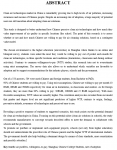Exploring Chinese Demand For Clean Air Technologies: University Student’s Willingness-to-pay For Air Purifiers In Shanghai And Rate Of Adoption
Abstract Category: Other Categories
Course / Degree: Technology Economics and Management
Institution / University: School of Economics and Management / Tongji University, China
Published in: 2015
Clean air technologies market in China is remarkably growing due to high levels of air pollution, increasing awareness and income of Chinese people. Despite an increasing rate of adoption, a large majority of potential users are still uncertain about adopting clean air solutions.
This study is designed to better understand how Chinese perceive clean air technologies and how much they value improvement of air quality in specific locations like school. The point of this research is to assess whether or not and how much Chinese are willing to pay for air cleaning solutions, based on a contingent value model.
The chosen environment is the higher education (universities) in Shanghai where thanks to an online and bilingual survey, students were asked the most they would be willing to pay out of pocket each month for clean air technologies, in three specific locations and conditions (dormitories, classrooms and during outdoor activities). Contrary to common willingness-to-pay (WTP) studies, this research tries not to overestimate using strict assumptions. The survey data also allows us to understand which variables are favorable to adoption and to suggest recommendations for the industry players, schools and the government.
Out of a 556 answers, 504 were used (Chinese and foreign students, from Bachelor to PhD).
90% of Chinese students are willing to pay. Using strict assumptions, Chinese are willing to pay per month 10 RMB, 6RMB and 7RMB respectively for clean air in dormitories, in classrooms and outdoor. As for foreign students, they are more than 90% willing to pay: 30RMB, 20RMB and 25 RMB respectively. With more favorable assumptions, WTP values are sensibly higher. The correlation analysis also revealed from our model that gender and degree level are not significant predictors of higher WTP, contrary to origin, feelings, preventive attitude, awareness of technologies and perceived ease to use.
Revealing a positive response of students to suggested scenarios, this study points out the potential demand for clean air technologies in China. Focusing on this potential niche (clean air solutions in schools), the study recommends manufacturers to converge towards described offers to meet the demand, to collaborate with schools and the government.
To promote air purifiers or implement such equipment projects, schools (not only from higher education) should not underestimate the prescriber role of Chinese parents and the higher WTP of international students. The government should also help building a dominant design by means of clear standards, more sensitization and possibly subsidies.
Thesis Keywords/Search Tags:
air purifiers, willingness-to-pay, Shanghai, Chinese College Students, rate of adoption
This Thesis Abstract may be cited as follows:
No user preference. Please use the standard reference methodology.
Submission Details: Thesis Abstract submitted by Brandon Cheneson from France on 30-Sep-2015 17:31.
Abstract has been viewed 1678 times (since 7 Mar 2010).
Brandon Cheneson Contact Details: Email: brandon.cheneson@gmail.com
Disclaimer
Great care has been taken to ensure that this information is correct, however ThesisAbstracts.com cannot accept responsibility for the contents of this Thesis abstract titled "Exploring Chinese Demand For Clean Air Technologies: University Student’s Willingness-to-pay For Air Purifiers In Shanghai And Rate Of Adoption". This abstract has been submitted by Brandon Cheneson on 30-Sep-2015 17:31. You may report a problem using the contact form.
© Copyright 2003 - 2026 of ThesisAbstracts.com and respective owners.
